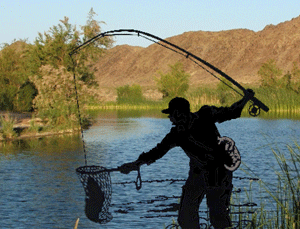|
FLY CASTINGA to Z
Even Rembrandt and Michelangelo had to practice. Before Rembrandt painted his famous work, The Night Watch, he had such a hard time selling his art that he had to declare bankruptcy (1656). Before Michelangelo painted the Sistine Chapel in the early 16th century, he was a famous sculptor and not really into the medium of painting with oils. So before you can become the Rembrandt or Michelangelo of the fishing world, you’ve got to practice. This will take no less than five minutes. It may take years to perfect the art but it will definitely not take less than five minutes. So, if you are ready to learn and practice, keep reading. It would be wise, but not absolutely essential, to learn some of the terms associated with fly casting. Several come to mind: grip, stance, pick-up and lay down cast, timing, slack and tight line, back cast, mending, roll cast, double-haul cast, loading the rod, drift, tight loop, casting stroke, forward cast, single haul, false casting, line stripping, etc., etc, etc. I could go on but I think I’ve mentioned the most important terms already. Let’s start with the fly casting grip. Grip the rod by the upper part of the cork and make sure the line guides and reel are facing the Earth. I know that sounds fundamental but some people really need to get down to the basics first. Your grip should not be white-knuckle tight or you will tire quickly and might wind up with arthritis. Just hold the rod in a natural easy position. How about your fly casting stance? If your target fish is in clear water, bend your knees and your waste. You do not want to be seen. Sneak up to a position where you can cast and accurately place your fly on the water without spooking the fish. Making your fly look and act as natural as possible is your goal. On the other hand, if the water is polluted, you probably will want to take a straight up stance, reverse direction and go bowling. Polluted water holds very few fish.
Open or closed stance? That’s up to you. I’ve used both but I tend to slip less with an open stance. Falling down in the water is kind of embarrassing. Try keeping one foot slightly ahead of the other. Timing takes time. It will not come to you in the first or second five minutes of practice. Timing is the ability to load the rod and make the cast in such a way that the fly ends up on target and presented so magnificently that the fish instinctively takes it for a ride. If time and its derivatives weren’t important why would we need such terms as take your time, time after time, be on time, timing is everything, and Einstein’s space-time continuum? Don’t rush. You’ll get better at casting with time. Now it’s time for a time out. The term pick-up and lay down simply refers to lifting your line from the water without causing it to tangle. Let's say that you are standing at the bank of a river and you cast upstream. As your fly drifts downstream, you are watching your fly or strike indicator and hoping that you'll connect with a fish. You've mended your line once or twice to keep the fly drifting naturally (no drag) but unfortunately, no dice - er, no takers. You now must lift your line off the water and try again. Here's what to do: slowly lift your rod until it's in the 12 o'clock high position and either perform a false cast or turn towards upstream and cast again. However, don't lift too slowly or the line won't leave the water. And don't snap it up either or the line will become tangled. This is a maneuver which requires practice (about 5 or 10 minutes should do it). Your worst enemy is slack line: line which is loose somewhere between either the fly and the rod tip or the rod tip and the reel. Trying to set a hook with lots of loose line is an exercise in futility. Loose lines lose lunkers. When you fly cast to a fish you should immediately remove slack line, thereby keeping the line as tight as possible. That way you are in a position to react quickly to a strike and will have a much easier time setting the hook. A trout and many other species of fish, can spit out a fly in under 1/10 of a second. With slack in your line, the fish has got you beat every time. "Tight Lines" is synonomous with catching more fish. I have come across many, many videos on the subject of fly casting. Below are three videos from Tight Lines Fly Fishing that I and my fly casting buddies unanimously agree are some of the best available. They show in simple to understand format the art of the cast. Please view and enjoy. There are basically two schools of thought when it comes to casting. Some experts believe that the best basic cast involves the straight overhand (noon to six) approach. This is where the back cast (the rearward movement of the rod and line, also called the Sweep) travels in as straight a line as possible in its movements. Others, myself included, believe that the best cast is the one most natural to you. Some folks like to cast straight overhead (sort of the way Johnny Padres pitched for the Dodgers in the 1950's), and some like the 45 degree angle, while others love to pitch their flies sideways. If it feels good then do it. Casting (getting your fly to a fish without scaring the living daylights out of it) does not have to be done only one way. Many situations develop that force you to be innovative. Most anglers are taught that to properly cast a fly you must not break your wrist or go beyond the 10 o'clock to 2 o'clock position, But according to Lefty Kreh, now an octogenarian but still considered one of the best fly casters of all time, the proper cast should be done using your body and not your upper arm. By using your body motion the power of the cast is greater and the risk of injury to your wrist and rotator cuff is lessened.
Loading the rod refers to bending it during your back cast. This is where the power to toss the line comes from. To do this you don't have to be Superman. Don't waste a lot of time trying to bend your rod to the breaking point. The best distance casters simply employ proper techniques while expending minimal energy. They make it look effortless much like Freddie Couples does when he hits a golf ball. Practice technique, and power comes easily. What is the proper loop for a successful cast? The answer is: the tight loop because less is more. The smaller your loop the tighter your cast. Loops refer to the curve of the line in the back cast and the way that loop unfurls in your forward cast. The best way to make a tight loop and thereby getting the most distance and accuracy out of your cast is to keep the cast tight. In other words, try to keep your casting angle (no matter which direction it comes from) short. A cast from 11 o'clock to 1 o'clock will produce a smaller, tighter loop than will a 10 o'clock to 2 o'clock cast.
Many times you will get into a situation where a high bank or shrubs are close by or directly in back of you. In this situation you will be using a roll cast. According to Jason Borger, with whom I concur wholeheartedly, the roll cast is useful when obstacles behind an angler prevent a normal back cast. Those who don't yet have this cast in their arsenal may assume that the roll cast is a special technique requiring expanded abilities, and a whole new set of motions. Not at all. A basic roll cast is nothing more than a standard overhead cast made with different timing! Even a beginner can make roll casts. The two keys to roll casting are proper timing and controlled application of energy. The Roll Cast #1. Begin with the rod tip parallel to the water's surface. #2. Lift your arm up-and-back, going slowly and smoothly, allowing the line to slide across the water toward you. #3. Tip your wrist back until the rod is in the one o'clock position and the line hangs by your side. This will form a D-Loop in your line. Make a karate-chop forward stroke to roll the line out in front of yourself. Stop high to aerialize the line. Stop low to keep it on the water.
#1 - Lift the line off the water as in any normal cast. #2 - Let the back cast unroll behind you until you feel a slight pull backwards on the rod. Timing is important here. You want your line to make a small loop so keep the back and forward casts short. #3 - Bring your fly rod forward but do not let the line touch the water. Wait until the line is out in front forming a small loop. Repeat all movements until you are ready to make your final cast.
The way to offset drag is by “mending” your line. ending simply put is moving the line after it's on the water.To achieve a good upstream mend, you've got to throw a certain portion of your line upstream of your fly. But getting your line to move up and down the river is harder than it sounds; most beginners end up dragging their flies underwater during the mend. To avoid this, you must lift the part of the fly line that you want to mend off the water, leaving the un-mended part of the fly line wet. There are five ways to get a good mend: #1 Mend as soon as the fly touches down, before the line has time to marry the water's surface. #2 Begin the mend with your rod tip close to the surface of the water. Make sure you don’t have a bit of slack in the line or you’ll be wasting your cast. #3 Be sure to mend enough line or the current will cause the line to drag the fly. #4 Lift your rod tip high, even over your head if need be, during the mend. This allows you to pick up more line and to avoid dragging the line across the water. #5 Mend as though you mean it. A weak mend rarely moves enough line. With a bit of practice you'll figure out just how much power is needed to move the line you want to move without disturbing the fly. What's the difference between a single-haul and a double-haul? A single haul is a downward pull on the line only during the back cast OR only during the forward cast. Most fly fisherman fishing on streams and rivers use the single haul almost exclusively. A double haul is a downward pull on both the back cast AND the forward cast and is employed mainly when fishing for the big guys on oceans, bays, inlets, lakes, and seas.
Click here for a DOUBLE HAUL VIDEO PRESENTATION To play the video, go to C/NET and download your free Riva player. Stripping Line refers to pulling fly line off of your reel so that you can make your casts. You can start by pulling off a couple of feet or the length of half a football field. It really doesn't matter how much line you start with. Your fishing conditions will often dictate the amount of line needed to start. Remember, first you strip, then you shoot. Don't take this out of order or it may become quite messy. Shooting Line is the term used to describe slack line being launched out of your hand toward a target in ever increasing lengths. Actually, with slack line at your feet all you need to do is hold the rod with your right hand (assuming you cast righty) and pinch a bit of line with your left hand and then make your cast. When the stop of the rod is made - say at the 11 o'clock position - your left hand releases the line (guiding it if you wish by making a circle (an 'o' ring) with your thumb and forefinger). This "shooting" allows the momentum of the line, which is traveling forward, to pull some of the slack line out. To increase your cast just repeat this procedure as often as needed until your fly reaches its intended target. 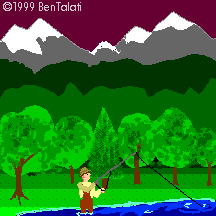
Some fly casters wait too long and some release the line too early. For this reason you must practice, practice, practice for a steady 15 minutes to an hour to get the timing just right. I have now covered most of the important points of fly casting. I hope you have learned a bit and were sufficiently entertained. Please rummage around the rest of my ever-growing web site and comment via email whenever you get the urge. Stay with us for future articles on all sorts of things related to the sport of
fly fishing.
And as always, have fun.
WANT A DISCOUNT COUPON? Just click the " Online Fly Shop" bar and sign up for a free account. You will receive a coupon worth 10% off your next purchase. We take discounting seriously. Return from Fly Casting to Fly Fishing Discounters Home Page
|








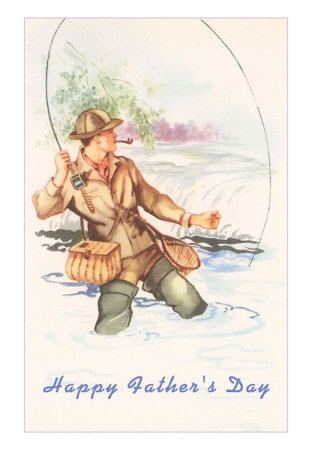
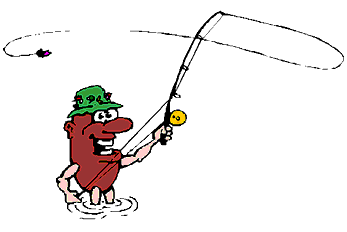 Using you body will force most of your casts to be at an angle. As long as you continue to point the rod tip at your target, the line will follow. So don't go all wiggly by beginning a cast at 45 degrees and ending it at 90 degrees. If you start at a 45 degree angle finish there as well. If you start your cast from the side at 90 degrees then finish it at 90 degrees.
Using you body will force most of your casts to be at an angle. As long as you continue to point the rod tip at your target, the line will follow. So don't go all wiggly by beginning a cast at 45 degrees and ending it at 90 degrees. If you start at a 45 degree angle finish there as well. If you start your cast from the side at 90 degrees then finish it at 90 degrees.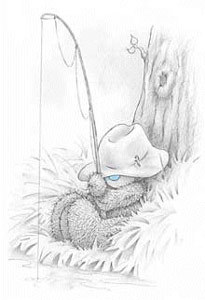 What's a false cast? The false cast has two distinct purposes. First it is used when you need to change directions between casts. The false cast is repeated one or two times and in rare situations maybe even a third or forth time to help you move to the right or left, not letting it lay on the water's surface until your final cast. Second it is a great cast to use to help dry out a water logged dry fly (although using floatant often on your fly will pretty much keep your fly dry anyway.)
What's a false cast? The false cast has two distinct purposes. First it is used when you need to change directions between casts. The false cast is repeated one or two times and in rare situations maybe even a third or forth time to help you move to the right or left, not letting it lay on the water's surface until your final cast. Second it is a great cast to use to help dry out a water logged dry fly (although using floatant often on your fly will pretty much keep your fly dry anyway.)

